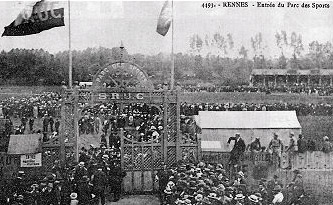History of Stade Rennais Stadiums
Publié le 17 July 1999 à 00h42 bySince 1901, the Stade Rennais has known several grounds to finally settle down on the Route de Lorient, where the team plays since... 1912.
10 March 1901 - September 1912: various grounds
During that period, the Stade Rennais played on various pitches: The first one was on the Boulevard Voltaire, another one was located on the Faubourg de Brest and the last one, where the team played for several years, was located on the western outskirts of the Brittany capital, on the Vilaine banks, in La Mabilais. That pitch was very similar to a field and was regularly flooded in winter. Duckboards were placed to avoid spectators to wet their feet, and the playground limits were marked by a simple rope
The ground belonged to the Richier Brothers.
The highest attendance was reached on February 11th 1912, for a derby against the US Saint-Servannaise: 5,000 spectators!
September 15 th, 1912 : Parc des Sports de la Route de Lorient
In September 1912, on Mr. Folliard’s (president), and Mr. Richier’s initiative, the SRUC leaves their pitch in La Mabilais to move in, still close to the Vilaine banks, in the Parc des Sports de la Route de Lorient (Precisely on the 111, Route de Lorient), based, as its name indicates, on the side of the road to Lorient.
Large, covered stands (6000 to 7000 places) and refreshments stalls were available to the many spectators.
The first match on this new ground was played on September 15th, 1912, as a friendly, and ended up with a first victory for the SRUC : 6-1 against the SA du lycée de Rennes.
For the record, Brizard was the first ever goalscored in this new Stadium, Verlet was the first captain to stride on the pitch, and Ruesch was the first foreign player to play in Rennes.
Before World War II
The Stadium will know a couple of modifications over the years, with, notably, the setting of a fence around the pitch between the 1935-1936 season, the installation of a roof on the second grandstand on the North Side, and the refurbishment of the Southern Stands.
The Stadium’s capacity will be brought up to 12,000 places (for 1,5 millions of francs), with additional stands being built and the addition of dressing rooms.

During the War
American troops are being based inside the Parc des Sports de la Route de Lorient.
After the War
1954-1955: A 3,000 seats reinforced concrete stand is built and inaugurated on December 11th, 1955 against Nantes (Estimated cost of the works:100 Millions of Francs). A wind breaking roof is fitted on the Stands along the Route de Lorient : The stadium’s capacity is now reaching 13,000 places, including 7,000 seats.
1956-1957, a grandstand with 10 000 places (including 2 000 seats) is built along the Vilaine : The Stadium’s capacity raises to 20 000 spectators.
The Parc des Sports de la Route de Lorient becomes Stade de la Route de Lorient, but the town rejects a proposition to change this last name in October 1981.
In 1986, a new lawn is stalled in the Stadium
The Latest Works
In 1996, the Stade de la Route de Lorient was shortlisted to host fixtures of the 1998 World Cup, conditional to an expansion of the Stadium. This was refused by the City’s administration.
However, the building of a new stadium began in 1999 to end in 2004. During that time, the Ville de Rennes stand was built, the PPR-Vilaine stand was destroyed and rebuilt, the Ouest-France stand (formerly Mordelles stand) and finally the Super U-Lorient were renovated

The Stadium has now 31,127 seats and was inaugurated on August 18th, 2004 with a friendly game between the French national team and Bosnia-Herzegovina. The official inauguration was celebrated on October 23rd, 2004, after a league game between Rennes and Metz…

